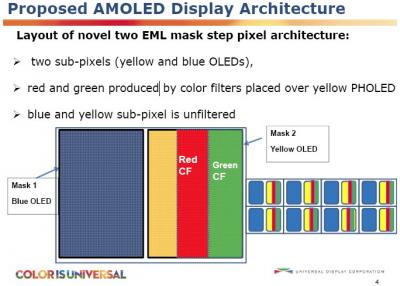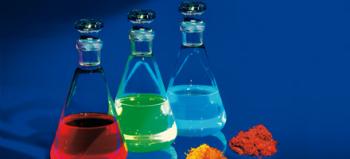OLED Lifetime: introduction and market status - Page 10
LG's latest OLED TVs last for 100,000 hours
In an interesting story about how LG Electronics' OLED quality control - and how the company tests its OLED TVs before shipping, the Korean company also reveals that its latest OLED TVs feature a lifetime of 100,000 hours - or 30 years of 10 hours per day. In 2013, LG's OLED panels had a lifespan of about 36,000.
In the same article, IHS is quoted saying that LGE sold 113,000 OLED TVs in Q1 2016, which is 96.4% of the market - which means that LGD produced about 117,000 TV panels. A couple of months ago LG Display itself said that it has shipped "less than 200,000 OLED TVs in Q1" - but it is still on track to sell around a million panels in 2016.
UDC proposes a new hybrid OLED structure to enhance lifetime and color gamut
Universal Display developed a new AMOLED structure that is a sort of WOLED - RGB hybrid structure. The idea is to use a large blue sub-pixel and a large yellow sub-pixel that is split into three areas - unfiltered and red and green filtered.

This structure is easier to deposit compared to a true RGB AMOLED (that requires very fine patterning of red, green and blue subpixels) but increase the aperture ratio compared to a WOLED architecture (which LG for example uses in its OLED TVs) - which increases the lifetime and color gamut of the display.
Cynora announces significant progress towards highly-efficient blue OLED emitters
Germany-based OLED emitter developer Cynora announced it has made significant progress in its highly efficient blue OLED emitter material developments during the last 6 months. The company's materials are not yet ready for commercialization, but the company believes it is on its way.

Cynora develops TADF-based emitters, focusing on blue-color emitters. Cynora has developed deep blue material reaching an EQE of 16.3% (at 100 cd/m2) compared to 3% reached in October 2015, a factor 5 improvement in six months.
Molecular Glasses announce efficient phosphorescent OLED host materials
 OLED material developer Molecular Glasses announced that its phosphorescent host material was demonstrated to improve the lifetime of OLED devices by up to 1,500%, with external quantum efficiency of 20% and minimal luminance roll-off. This is in comparison to the "state-of-the-art phosphorescent host mCBP".
OLED material developer Molecular Glasses announced that its phosphorescent host material was demonstrated to improve the lifetime of OLED devices by up to 1,500%, with external quantum efficiency of 20% and minimal luminance roll-off. This is in comparison to the "state-of-the-art phosphorescent host mCBP".
It is not clear to which host this is compared to, but the company says that these results were obtained following a 96 prototype device experiment that was recently completed at OLEDWorks' DOE approved laboratory.
New method to extend the lifetime of TADF emitters may also enhance phosphorescent OLEDs
Researchers from Kyushu University managed to drastically increase the lifetime of TADF OLED emitters - by more than eight times. This was achieved by a simple modification to the structure of the device - putting two thin (1-3 nm) layers of Liq (a lithium-containing molecule) on each side o the hold blocking layer.

The researchers started with a TADF device, in which the lifetime is only about 85 hours (LT95). This is under "extreme brightness" to accelerate testing. With the new design and some extra modifications, the device's lifetime increased to 1,300 hours - over 16 times better than the initial device. This is a great achievement - even though this is not enough for commercialization yet.
Dell announces a $4,999 30" 4K OLED monitor
Dell launched a new monitor, the Ultrasharp 30 OLED. This high-end monitor adopts a 30" 4K OLED panel and features a 0.1 ms response time, 100% AdobeRGB, narrow-bezel design and USB-C connection. The UltraSharp 30 OLED will ship by the end of March 2016 for $4,999.
Dell said that it developed special technologies to compensate for image-burn in (using pixel-shifting) and the relatively short OLED lifetime (using a presence detector that switches off the display when no one is in front of the monitor).
An interview with Idemitsu Kosan's electronic material's chief
 Idemitsu Kosan is a large multinational Chemical company based in Japan that is supplying OLED materials for OLED producers. Idemitsu has OLED business units in Japan, Taiwan, Korea and China and is collaborating with UDC, LGD, AU Optronics, Doosan and others.
Idemitsu Kosan is a large multinational Chemical company based in Japan that is supplying OLED materials for OLED producers. Idemitsu has OLED business units in Japan, Taiwan, Korea and China and is collaborating with UDC, LGD, AU Optronics, Doosan and others.
Hajime Nakamoto, the head of the Electronic Materials Department at Idemitsu was kind enough to answer a few questions we had. Mr. Nakamoto joined Idemitsu in 1984 and has been involved with OLEDs since 2007.
Q: Hajime, Thank you for your time. Idemitsu has been one of the leaders in OLED materials for a very long time. Can you tell us what kind of materials you currently offer for OLED panel makers?
Idemitsu offers almost all kinds of OLED materials to OLED panel makers. Idemitsu is particularly well-known for its fluorescent blue host and dopant materials and transport materials, which offer advantages to OLED panel makers.
Merck reveals the efficiency and lifetime of their red and green soluble phosphorescent emitters
In January 2013, Merck said that the performance gap between soluble and evaporable OLED emitters is closed - at least in the lab. Earlier this month at the OLED World Summit the company revealed the development results of their phosphorescent materials, comparing them to UDC's materials (as published on UDC's website).

Merck's red emitter features an efficiency of 19.1cd/A, a lifetime (L90) of 5,900 hours and the CIE is (0.66, 0.34). UDC's red material features an efficiency of 29 cd/A and a lifetime of 23,000 hours. Merck's green material features an of 76.4cd/A, a lifetime of 5,200 hours, and the CIE is (0.32, 0.63). UDCs green features an efficiency of 85 cd/A and lifetime of 18,000 hours, The CIE is similar (0.31, 0.63).
ITRI developed a highly efficient blue OLED emitter based on plasmon-coupled green PHOLED
Taiwan's ITRI research institute developed a long-lasting OLED blue emitter. The researchers used a green phosphorescent emitter with a new double metal structure - that emits a blue light. The so-called Plasmon-Coupled Organic Light Emitting Diode (PCOLED) structure's lasts 27 times as long as a blue fluorescent emitter.

The researchers explain that a regular green phosphorescent emitter always emits a very weak emission. By using the double-metal structure, more plasmons are generated which means a larger blue emission. This is not an up-conversion process - but merely a change in conditions within the green material. This condition was actually discovered by accident.
Researchers develop an efficient deep-blue PHOLED
Researchers at the University of Michigan developed a new deep-blue energy-efficient phosphorescent OLED (PHOLED) emitter. The researchers say that this is the brightest deep-blue PHOLED ever reported - in fact it is about 10 times brighter than previous deep-blue PHOLEDs. The lifetime of this material is still very low, and future research will attempt to stabilize the molecule.

The new emitter is based on a N-heterocyclic carbene iridium-III complex molecule. This is an efficient compound because its design reduces the chances that light-emitting excitons will either get lost as heat or destroy the compound itself. This research is sponsored by Universal Display Corporation and the U.S. Air Force.
Pagination
- Previous page
- Page 10
- Next page

